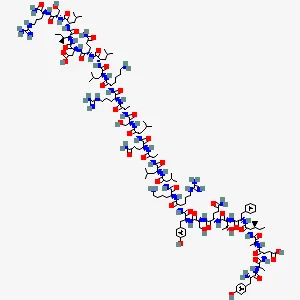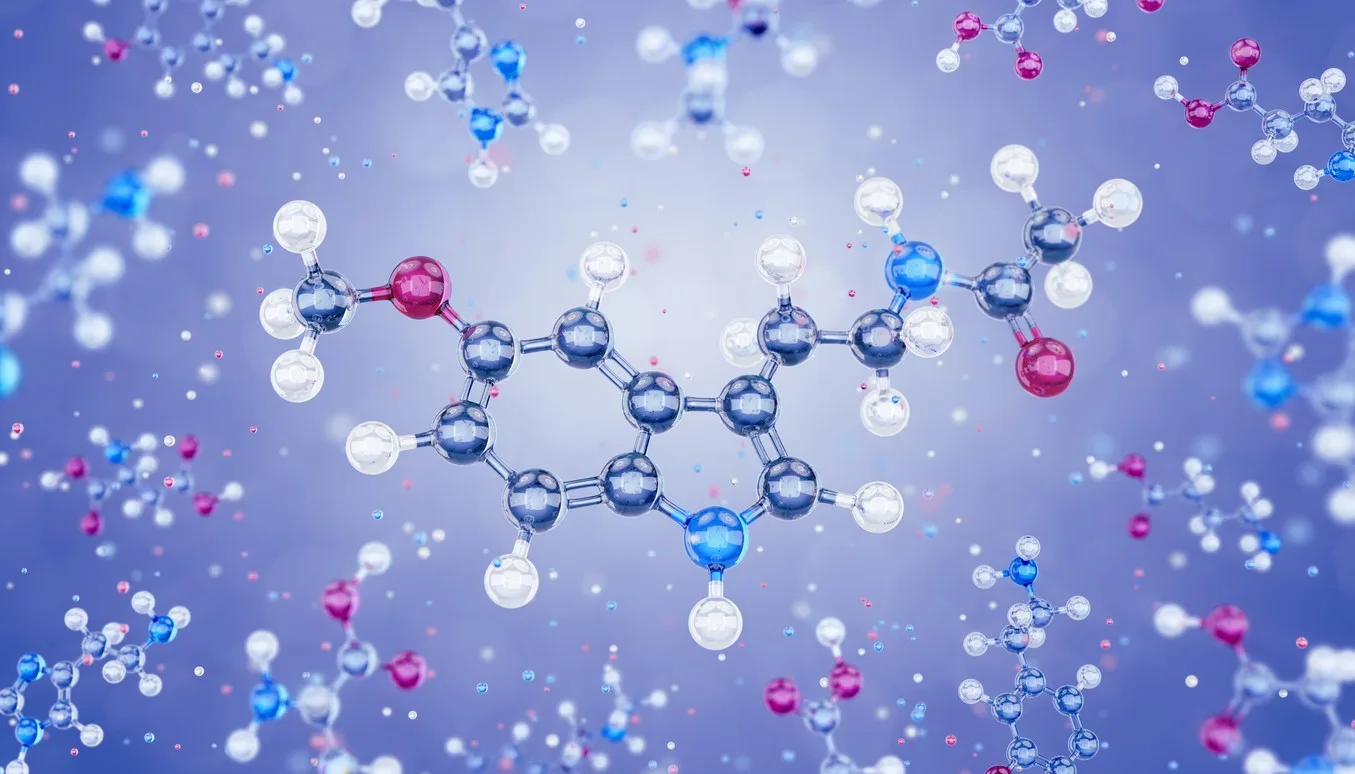GHRP-2 (Growth Hormone Releasing Peptide-2), meanwhile, is a ghrelin-mimetic peptide that is speculated to increase growth hormone secretion through pathways like those exposed to endogenous ghrelin. When exposed to research models in combination, these peptides may exhibit synergistic impacts that increase overall growth hormone release.(1)(2)(3)

Figure 1 – Modified GRF (1-29) Chemical Structure(11)

Figure 2 – GHRP-2 Chemical Structure(12)
Mechanism of Action
Modified GRF 1-29 and GHRP-2 are suggested to stimulate growth hormone release through complementary mechanisms. Modified GRF 1-29 is hypothesized to bind to growth hormone-releasing hormone receptors, supporting the pituitary gland’s response and encouraging more sustained growth hormone release. The structural modification, in which four amino acids are replaced, appears to increase its resistance to degradation, allowing for more impactful receptor engagement and longevity within the system.(3)
GHRP-2, conversely, is considered to bind to ghrelin receptors and triggers the release of growth hormone through several pathways, including potential calcium channel modulation, cAMP pathway activation, and protein kinase C signaling. Together, these peptides appear to target both the release and duration of growth hormone activity, which may suggest the potential for optimized growth hormone regulation under controlled research conditions.(4)
Modified GRF 1-29 and GHRP-2 Research Studies
Growth Hormone Modulation and Tissue Activity
Pre-clinical studies have examined the profiles of the Modified GRF 1-29 and GHRP-2 peptide blend, with a focus on its suggested ability to promote growth hormone (GH) synthesis and release in animal models. In studies involving guinea pigs and rabbits, the peptides were introduced to observe potential systemic impacts beyond growth hormone release, providing insights into their broader pharmacodynamic characteristics.(5)
As per these studies, it appears that the peptides indicated no significant activity on the central nervous system, with the primary observable impact limited to the isolated gastrointestinal tract. Specifically, studies reported an increase in the motility of the isolated ileum in rabbits and heightened muscular tissue contractions in the isolated ileum of guinea pigs. Importantly, these impacts were localized, with no measurable impact observed on renal function, respiratory rate, gastric secretions, or hemodynamic parameters in the blood system. These findings suggest that the peptide blend’s primary action is to stimulate growth hormone release without affecting major organ systems under the studied conditions.
Hunger Hormone Signaling Modulation and GH Release
A controlled clinical study(6) investigated the potential impacts of peptides on hunger hormone signaling and growth hormone (GH) secretion. A cohort of research models was divided evenly into an experimental and control group. One group was given a peptide compound, while the control group was given a saline solution over five hours. To assess the impact on appetite, both groups allowed researchers to monitor and compare their caloric intake over a set period.
Reports suggest that the peptide-introduced group indicated a 35% increase in food consumption compared to the saline-group. This reported to better support the appetites of the models, normalized based on their mass, suggests a notable potential of the peptide on hunger hormone regulation. Additionally, the research models introduced to the peptides apparently displayed a significant rise in circulating growth hormone levels relative to the control group. These findings may imply that the peptide blend may influence appetite control and growth hormone release. It warrants further exploration into its underlying mechanisms and potential research implications in the field of appetite modulation and growth hormone regulation.
Modified GRF 1-29 and GHRP-2 in Growth Regulation and Metabolic Modulation
Recent clinical research has studied the efficacy of growth hormone secretagogues (GHSs) and growth hormone-releasing peptides (GHRPs) within controlled research environments. These studies were primarily aiming to evaluate physiological and metabolic responses to peptide introduction. Research protocols included monitoring for specific physiological markers over time, providing insights into the peptide blend’s possible influence on growth hormone regulation and other metabolic functions.(7)
Upon analyzing the data, researchers observed that introducing the peptide possibly corresponded with several physiological impacts. In non-mature populations, an increase in linear growth rates was reported, aligning with the peptides’ potential role in supporting developmental growth pathways. Among mature models, peptides appeared to correlate with an increase in lean muscular tissue mass, better-supported appetite regulation, and possible metabolic support that may favor muscle cell anabolism. Additionally, for models with higher BMI, the introduction of GHSs and GHRPs appeared to indicate promising reductions in bone turnover rates and more regulated sleep patterns, potentially indicating broader metabolic impacts beyond growth hormone modulation.
Existing findings suggest that GHSs and GHRPs might even “increase lean mass, reduce fat mass, increase exercise tolerance and maximum oxygen uptake, [support] muscular tissue strength, and [support] linear growth. Long-term studies of GH […] offer conflicting results.”(7)
Growth Hormone Regulation and Hypothalamic-Pituitary Interaction
Since 2000, multiple clinical studies have analyzed the potential of peptides that stimulate growth hormone release in matured research models of growth hormone deficiency (GHD). Data collected from these studies is said to suggest that these peptides may exert their impacts through dual mechanisms: (i) directly stimulating the anterior pituitary gland to secrete growth hormone (GH) and (ii) acting on the hypothalamus, specifically the arcuate nucleus, to potentially regulate GH release.
The blend of GHRP-2 and Modified GRF 1-29, each targeting distinct receptors, is speculated to increase GH concentrations in research models by an amount significant to researchers. However, the precise biochemical pathways and receptor-level interactions remain an area of ongoing research.(8)
Furthermore, research suggests that GHRP-2 and similar peptides may influence additional physiological parameters, such as appetite regulation, cardiovascular tone, and circadian rhythms, likely through agonistic activity at specific receptors within the hypothalamic and pituitary regions.
A study conducted by V. Mericq et al. explored the impacts of growth hormone-releasing peptides in non-mature models of GHD and experiencing growth failure.(9)
Over eight months, six juvenile models received GH-stimulating peptides, with close monitoring for changes in serum GH concentrations. Results suggested a consistent, marked increase in GH levels throughout the study duration, sustained in a manner indicating peptide efficacy even shortly after the intervention period concluded.
Growth Hormone, Cortisol, and ACTH Levels at Varied Cellular Ages
In a controlled clinical study,(10) researchers explored the impacts of growth hormone-releasing peptides on several hormone levels, specifically examining growth hormone (GH), cortisol, prolactin, and adrenocorticotropic hormone (ACTH) in male subjects across two distinct cellular ages. The study sample consisted of two cohorts: a cohort of younger males and an older cohort of matured male models. Research models were exposed to a peptide regimen designed to stimulate endogenous growth hormone secretion.
Based on the results of the study, it appeared that both groups had increased circulating growth hormone levels following peptide introduction; however, a statistically significant rise was observed in the younger group compared to the matured models, suggesting possible age-dependent variability in the peptide’s efficacy on GH release. Additionally, the peptides appeared to indirectly stimulate ACTH and cortisol levels in both cellular age groups, although the elevation was more pronounced in the juvenile models. A mild increase in prolactin levels was also reported, suggesting that the peptides may engage multiple hormonal pathways.
The findings suggest that peptide blend may impactfully influence the secretion of key hormones involved in the endocrine system, with observed variations across cellular age groups. While these results underscore the potential of peptides to modulate hormonal secretion, further research is required to elucidate the precise mechanisms and age-related factors that influence these outcomes. Currently, such peptide blends are available solely for educational and experimental research purposes, and additional studies are needed to understand the broader implications of these findings.
NOTE: These products are intended for laboratory research use only. This peptide is not intended for personal use. Please review and adhere to our Terms and Conditions before ordering.
References:
- Garcia JM, Merriam GR, Kargi AY. Growth Hormone in Aging. [Updated 2019 Oct 7]. In: Feingold KR, Anawalt B, Boyce A, et al., editors. Endotext [Internet]. South Dartmouth (MA): MDText.com https://www.ncbi.nlm.nih.gov/books/NBK279163/
- Phung LT, Sasaki A, Lee HG, Vega RA, Matsunaga N, Hidaka S, Kuwayama H, Hidari H. Effects of the administration of growth hormone-releasing peptide-2 (GHRP-2) orally by gavage and in feed on growth hormone release in swine. Domest Anim Endocrinol. 2001 Jan;20(1):9-19. https://pubmed.ncbi.nlm.nih.gov/11164330/
- National Center for Biotechnology Information (2023). PubChem Compound Summary for CID 91976842, CJC1295 Without DAC. https://pubchem.ncbi.nlm.nih.gov/compound/CJC1295-Without-DAC.
- Roh SG, He ML, Matsunaga N, Hidaka S, Hidari H. Mechanisms of action of growth hormone-releasing peptide-2 in bovine pituitary cells. J Anim Sci. 1997 Oct;75(10):2744-8. doi: 10.2527/1997.75102744x. PMID: 9331879. https://pubmed.ncbi.nlm.nih.gov/9331879/
- Furuta S, Shimada O, Doi N, Ukai K, Nakagawa T, Watanabe J, Imaizumi M. General pharmacology of KP-102 (GHRP-2), a potent growth hormone-releasing peptide. Arzneimittelforschung. 2004;54(12):868-80. doi: 10.1055/s-0031-1297042. PMID: 15646371. https://pubmed.ncbi.nlm.nih.gov/15646371/
- Laferrère, Blandine et al. “Growth hormone releasing peptide-2 (GHRP-2), like ghrelin, increases food intake in healthy men.” The Journal of clinical endocrinology and metabolism vol. 90,2 (2005): 611-4. https://www.ncbi.nlm.nih.gov/pmc/articles/PMC2824650/
- Sigalos, John T, and Alexander W Pastuszak. “The Safety and Efficacy of Growth Hormone Secretagogues.” Sexual medicine reviews vol. 6,1 (2018): 45-53. doi:10.1016/j.sxmr.2017.02.004 https://www.ncbi.nlm.nih.gov/pmc/articles/PMC5632578/
- Rogério G. Gondo et al, Growth Hormone-Releasing Peptide-2 Stimulates GH Secretion in GH-Deficient Patients with Mutated GH-Releasing Hormone Receptor, The Journal of Clinical Endocrinology & Metabolism, Volume 86, Issue 7, 1 July 2001, Pages 3279–3283, https://doi.org/10.1210/jcem.86.7.7694.
- Mericq V, Cassorla F, Salazar T, Avila A, Iñiguez G, Bowers CY, Merriam GR. Effects of eight months treatment with graded doses of a growth hormone (GH)-releasing peptide in GH-deficient children. J Clin Endocrinol Metab. 1998 Jul;83(7):2355-60. https://pubmed.ncbi.nlm.nih.gov/9661608/
- Emanuela Arvat, Lidia Di Vito, Barbara Maccagno, Fabio Broglio, Muni F Boghen, Romano Deghenghi, Franco Camanni, Ezio Ghigo, Effects of GHRP-2 and Hexarelin, Two Synthetic GH-Releasing Peptides, on GH, Prolactin, ACTH and Cortisol Levels in Man. Comparison with the Effects of GHRH, TRH and hCRH, Peptides, Volume 18, Issue 6, 1997, Pages 885-891, ISSN 0196-9781, https://doi.org/10.1016/S0196-9781(97)00016-8
- Figure 1 – https://pubchem.ncbi.nlm.nih.gov/compound/56841945
- Figure 2- https://pubchem.ncbi.nlm.nih.gov/compound/6918245
